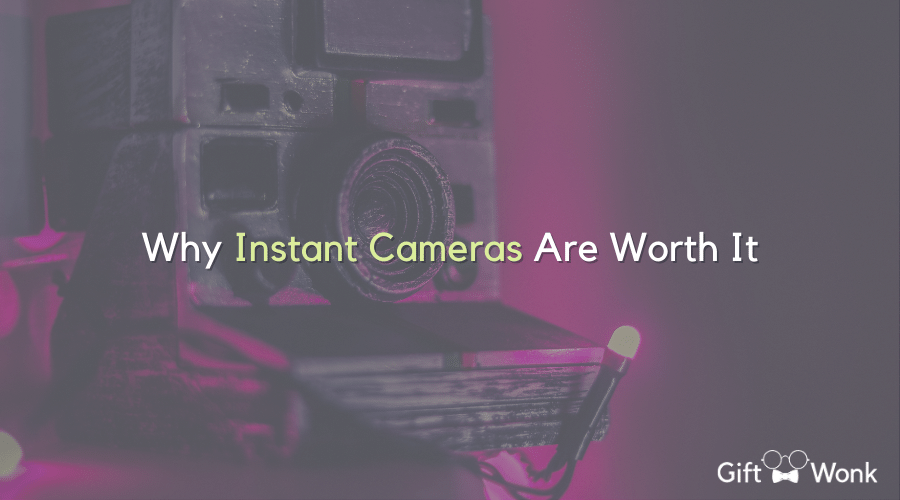
!! DISCLAIMER !! This site may contain Amazon & other affiliate links.
This means if you click on one of the product recommendation links, this site may receive a small commission. This is at no extra cost to you and may include exclusive discounts when possible. This helps support this site and allows us to keep making content like this. Thank you for your support!
Snaps From The Past – Why Instant Cameras Are Worth It
Why instant cameras are worth it – Despite millions of megapixels and artificially intelligent autofocus, the best instant cameras are still important today.
Since the 1940s, the technology at the heart of the best instant cameras has been around, and because the film must be purchased in packs, you spend money every time you push the shutter button.
It’s the simplicity of this camera that makes it so appealing. After all, they are so straightforward that they produce some of the best cameras for kids and beginners.
And the results are completely distinctive; the greatest instant cameras produce a distinct type of shot that people spend hours attempting to replicate using Instagram effects and Lightroom presets. But nothing compares to the genuine thing!
The greatest instant cameras are also easy to use; there are no settings to fumble with, no focus points to fumble and play with – you simply aim the camera at your subject(s), frame your shot, and click the shutter button.
As a result, instant cameras are perfect for families, parties, weddings, and even allowing children to be creative.
A new type of digital instant film camera has also emerged, combining the thrill of instant photography with the convenience of modern technology.
Canon, Fujifilm, Kodak, and Polaroid have all entered the realm of digital instant cameras, creating smaller digital cameras with a built-in digital printer and sensor.
We’ve separated our best instant camera guide into film and digital parts. If you choose the former, don’t forget to stock up on instant film, so you have plenty of snaps for your shooting!
Choosing The Best Instant Camera
Choosing the best instant camera for your needs is key to getting the most out of your experience. Look at factors such as size, shoot distance, type of film you can use and even extras like editing features or adjustable timings.
Some cameras are designed for high-quality prints with large formats, while others may make smaller prints that can you slip into a wallet or album.
Check out print sizes available with each camera and make sure that it suits your needs. The right instant camera will offer crisp results with minimal hassle making it worth every penny!
The objective of this buying guide is to provide an overview of this unique camera to individuals considering purchasing an instant camera.
This article also intended to provide information that will assist the user in selecting an appropriate instant film camera from the several options available.
Instant Photography
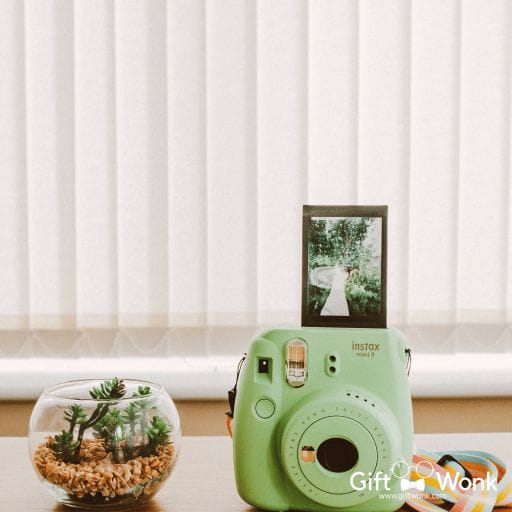
An instant camera includes a self-developing film that can create a printed image minutes after the photograph is taken. This packet of self-developing film includes the chemicals needed to develop the film.
When a photograph is taken, a pod containing these chemicals bursts open, or the photograph is dragged out of the camera using specialized rollers.
Instant cameras meet the three-tier need of providing the consumer with aesthetics (because most cameras are also beautiful to look at), high-quality results, and time savings. The images produced by these cameras have a characteristic look that can be easily identified as a product of instant photography.
Important Features To Consider
Whatever type of instant camera you choose, there are a few key features and specs to consider. This will assist you in obtaining a pleasant and functional camera with which you are eager to experiment.
User-Friendliness

The camera’s user-friendliness is what makes it simple for everyone to use. To capture the perfect photo, most instant cameras need that a button beside the lens is switched on and the lens to be adjusted.
Shutter Speed
Many entry-level instant cameras have a fixed shutter speed of 1/60 seconds. This is an excellent all-around shutter speed that will eliminate blur while also attempting to maximize light-gathering potential to generate clean photographs.
However, certain higher-end instant cameras offer a wider range of shutter speeds, which more experienced photographers may find beneficial in various scenarios.
Tripod Socket
Even though it’s an instant camera, try placing it on a tripod to capture perfect landscape shots or timed group selfies. Your camera should have a tripod mount built into the bottom so that you can use it with a tripod or monopod.
Size
Instant cameras are available in a range of sizes, from the smallest to the most powerful. This determines how portable your camera is for times when you need to take it around or pack it up and go. Consider any parts that would make it difficult to transport, such as an extending flash.
Photo Dimensions

Instant camera film is available in a range of sizes, and you should select the format that best suits your needs. Because each instant camera can only print one size of the film, this will determine which camera you buy. We’ll go through film sizes in greater depth later.
Instant cameras may use a wide range of film sizes. Which photo size is optimal will be determined by your personal preferences.
- Mini (62mm x 46mm) – The mini-film type is the most common film size and produces photographs roughly the size of a credit card.
- Wide (62mm x 99mm) – This film type is ideal for photographers who want to use their instant camera to take more panoramic photos. They’re nearly twice as wide as the little film while remaining the same height. However, because of the larger film size, cameras are typically larger and heavier.
- Square (62mm x 62mm) – These images print in a perfect square, precisely like the old-fashioned instant cameras. They evoke an immediate sense of nostalgia, but they might be more challenging to center and frame for each photo.
On a serious note, you should be aware that not all cameras are compatible with the various types and sizes of picture paper. This means that if you want to shoot with Square film, you must first ensure that your instant camera supports the Square film size.
Selfie Mirror
While most instant cameras do not include a flip-out screen for selfies, many of them do include a small mirror near the lens.
When shooting a selfie, you can utilize this to place yourself roughly in the frame. If you intend to use your instant camera to take selfies, you should look for one having this capability.
In-Camera Editing
Some of the more sophisticated instant cameras take digital photographs. This enables you to apply filters and frames to your images, evaluate them before deciding which ones to print, and even reprint them.
Brightness Adjustment Dial
Some instant cameras include a particular brightness adjustment slider that will not only help you take perfect shots but will also guide the user through the picture-making process.
This feature calculates the ideal environment for photographing in terms of brightness and illumination. The camera will turn the adjustment dial to the position it believes is best.
Process Time
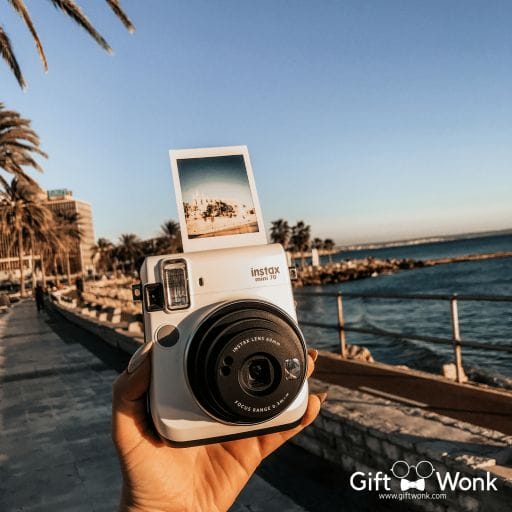
An instant camera produces the image almost immediately after it is shot. However, the image must be allowed plenty of time to process and dry without interruption.
The way the photograph is dried has a direct impact on its quality. It can take anywhere from 10 to forty minutes to develop the photographs. Spots on photographs are also common, but they usually disappear within 24 hours.
Brand
You may be tempted to buy an instant camera from a lesser-known brand in order to save money, but doing so may make it more difficult to obtain a repair or replacement if something goes wrong.
Instead, conduct some research and select a brand with a reputation for producing high-quality products. Today’s leading instant camera manufacturers are Fujifilm and Polaroid.
Additional Features
Along with the usual functions of instant cameras, several additional extra features are available. They’re intended to make it easier to operate your camera to capture clear, bright images while also maximizing simplicity of use.
Bluetooth
The ability to connect your instant camera to a computer via Bluetooth allows you to back up your favorite shots and immediately transmit them to a Bluetooth printer for larger sizes.
Furthermore, Bluetooth allows you to instantly upload your photos to a larger device for editing and balancing.
Flash Unit
Instant cameras with flash units allow you to shoot in a range of lighting circumstances without having to worry about your images being too dark. Your quick camera may include a built-in flash, or you can purchase one separately and use it remotely.
Depending on the model, these flash units might be rechargeable or single-use. Another repeating feature on the Polaroid instant digital camera is the incredibly popular self-timer. It is just as vital to use the best film for the camera as it is to use the perfect camera.
Self-Timer
Maybe you want to be in the picture as well! With a self-timer, you may set a countdown length, position yourself in front of the camera, and the camera will automatically turn off when the timer expires.
This function is becoming increasingly popular and is an excellent technique for shooting huge group photographs.
Different Modes
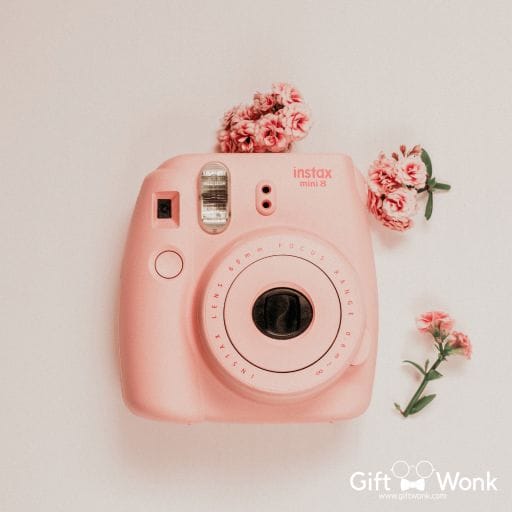
Photographers like adaptability, and you may want to use your camera to shoot a wider-angle photo or a selfie.
There are instant cameras on the market that have multiple modes for changing the focus, such as Selfie Mode, Landscape Mode, Macro Mode, and Hi-Key Mode.
Not all instant cameras have these settings, so make sure the one you’re interested in has the functionality you need.
Benefits of Instant Photography
The main advantage of an instant camera is that the photographer can view the results right away.
Polaroids are used in fashion photography to obtain a concept and assess the progress of the photograph before moving on to the main shoot on a conventional camera.
Polaroids have also been used in archaeology to capture crime scenes, record uncommon natural findings, and for a variety of other purposes. It was a common sight during 1950s parties.
Most instant cameras are also recognized to be more temperature resistant than ordinary cameras.
Top Manufacturers
Fujifilm
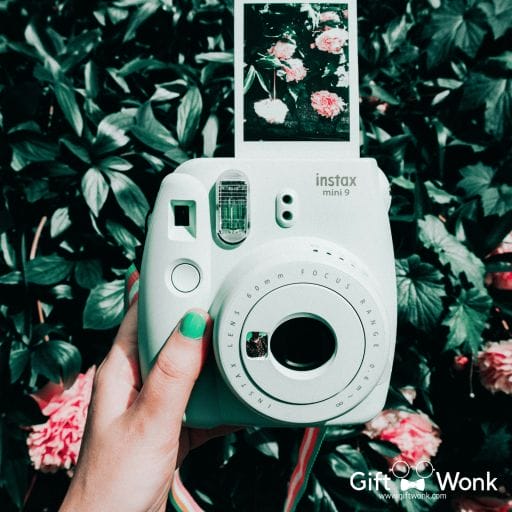
Fujifilm, headquartered in Tokyo, is one of the oldest firms in the development, production, service, and sales of cameras, color films, photo-finishing equipment, optical devices, printers, and other products. Fujifilm is one of the few remaining manufacturers of instant cameras.
Fujifilm Instax cameras are among the most adorable and entertaining instant cameras available.
Fujifilm Instax and Fujifilm Instax mini are two of the company’s most popular cameras. Fujifilm instant cameras and their associated films, Fujifilm Instax film and Fujifilm Instax Mini film, have always been popular.
Polaroid
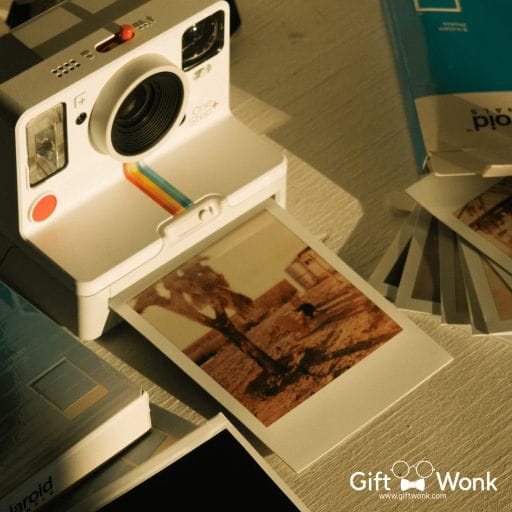
The term Polaroid is sometimes used interchangeably with an instant camera. This is most likely due to its status as the oldest company providing instant cameras and films.
Through cameras, consumer electronics, and instant photography, the company believes in emerging new technologies, trends, and the continuous evolution of the digital world.
As a result, it intended to produce Polaroid digital cameras. When Polaroid stated in 2008 that it would no longer produce instant cameras due to the popularity of digital cameras, there was an outcry from photographers who believed that instant cameras were a unique and irreplaceable medium, prompting Polaroid to reverse its decision. Polaroid camera films, like Fujifilm, are extremely popular.
Final Thoughts
When it comes to instant cameras, there are many reasons why they can be worth it. Not only are they convenient and easy to use, but instant cameras also let you physically hold your memories forever.
Not to mention, watching the photos form right before your eyes is incredibly satisfying! Investing in an instant camera allows you to capture moments that you once thought were impossible and explore your creativity like never before.
At the end of the day, instant cameras provide a unique experience that no other digital camera can offer.
The film isn’t just for old fogeys and hipsters; many people like taking pictures using a modern-day instant camera, much like our parents did with Polaroids back in the day.
Frequently Asked Questions
How to choose the best instant camera?
While most instant cameras are simple and inexpensive, there are a few important factors to consider when selecting the finest instant camera for your needs and budget.
The cheapest models are usually barely more than toy cameras with simple point-and-shoot capabilities. If you just want to take pictures at a party, these are fine.
However, settings such as macro-focusing will cost a little more, and hybrid digital functionality will be found at the top end.
This enables you to connect your camera to a smartphone for additional creative control – or to create actual copies from your smartphone’s camera roll.
Print quality and size should also be considered. Although no instant brand achieves perfect results (part of the retro appeal), Instax undoubtedly produces the most natural photographs.
Polaroid images have a dreamier appearance, which might be just as appealing depending on your tastes. Films also come in various diameters to accommodate individual cameras, so decide if you’ll want pocket-sized prints or something larger.
While instant cameras are often inexpensive, you must consider the expense of film. It can rapidly mount up, so pay attention to the price of each pack – and consider how many photos you’re likely to take on a regular basis.
Polaroid film is typically more expensive than Instax film; for the price of one pack of eight color Polaroid I-Type photos, you can acquire two packs of ten Instax Mini film.
To drastically reduce waste, certain instant cameras with digital screens or smartphone connectivity let you preview your images before printing them (and, therefore, the cost of dud snaps).
What’s the distinction between Polaroid and Instax?
The two most popular instant camera brands are Polaroid and Fujifilm’s Instax. While they both employ similar technology, using chemical processes to self-develop each image in your palm, the key difference is the type of film their cameras use.
Polaroid cameras use one of two types of film: the bigger I-Type film, which produces square format images, and the newer ‘Go’ film, which is used by the company’s tiny Polaroid Go camera. You can select between color and black-and-white film, as well as a variety of border colors.
Instax cameras support a wider range of film types, including Instax Mini, Square, and Wide film.
Because these, like Polaroid film, cannot be mixed and matched between cameras, selecting your favorite film type is a crucial element in selecting the right instant camera for you.
Which type of film is the best?
Polaroid’s I-Type has the advantage in terms of size, but Instax film is typically less expensive. For the price of a single pack of eight color Polaroid I-Type photos, for example, you can receive two packs of ten Instax Mini films.
Fujifilm Instax Mini
The most common instant film format, with images measuring only 62 x 46mm.
Fujifilm Instax Square
Fuji’s version on the Polaroid-popularized square format film. Cameras that accept these 62 × 62mm images are relatively limited.
Wide Instax
Although it is twice the size of an Instax small and twice the price, the photos are larger at 99 x 62mm.
I-Type Polaroid
I-Type film packs, designed for use in the Impossible I-1 and OneStep 2, do not include batteries and hence cannot be used with classic Polaroids.
Polaroid Go
The Polaroid Go film, Polaroid’s answer to the Instax Mini, measures 66.6mm x 53.9mm and is designed to work with the camera of the same name.
Polaroid 600 camera
The film was made for vintage Polaroid 600 cameras. It is also applicable in the Impossible I-1 and OneStep 2.
Polaroid Zink 2×3
Instant film that uses heat-sensitive ink to create images. Colors are more conventional than those found in Instax. Many Zink-based cameras and printers are compatible.
Are new instant cameras still being created?
Instant cameras may look out of date, but they are still manufactured. In fact, they’re becoming a more common picture format.
These modern remakes of retro cameras from the days when the analog film was the norm are intended to reproduce the approachable joy of point-and-shoot photography.
There are numerous reasons why you should get an instant camera. Unlike smartphone photography, instant cameras provide you with a physical print that you can hold in your hands, stick on the fridge, or share with your friends right away. It’s a fresh, tactile method to rediscover the joy of photography.
Another advantage of using an instant camera is how simple it is to shoot. The greatest alternatives are quite easy to use, making it simple to capture warm antique prints.
Most have only a few buttons and restricted shooting options, allowing you to concentrate on framing.
Furthermore, instant cameras are typically far less expensive than small cameras. As a result, they can be a terrific method for children to get into photography.
Analog photography has seen a renaissance in recent years, and the trend shows no signs of abating anytime soon. Instant cameras let you partake in the throwback craze without the steep learning curve, expense, or trouble of more advanced film photography processes.
Is it worthwhile to invest in instant cameras?
Features that suit one person’s shooting style or personal preferences may not suit another’s. It takes practice to shoot stunning images with instant cameras, but it’s well worth it.
What are the drawbacks of an instant camera?
- You will need to purchase photographic paper on occasion, which might be costly.
- Analog devices do not let you modify the photo before printing it.
- The majority of Polaroid cameras do not use rechargeable batteries.
What motivates people to purchase instant cameras?
Instant cameras are entertaining. A speedier camera will pique your interest in photographs more than your iPhone or DLSR.
A quicker camera will enable you to make cool, one-of-a-kind photographs that no one else will see. There is no doubt that a quick camera will come in handy at some point.
How can you prevent your film from fading?
If you store your instant film properly, it can endure for nearly 100 years. Instant film is known to degrade with time and is yellow in brighter areas. There are steps that can be taken to protect them from this fate.
Light Exposure,
Unfortunately, any images taken in direct sunlight will be ruined. This means that the best place to keep them is in a dark place where they will not be destroyed by the same light that might harm our skin.
Even if they are preserved properly in a dark place, there is still the chance of yellowing in the photo’s lighter portions.
Do Not Cut
It may be tempting to chop the photo to fit into specific frames, but do not do so. It can harm them and accelerate their degeneration. Not only that, but the chemicals within a Polaroid are poisonous, which could cause skin injury.
You can still preserve them after cutting, but they will not look the same, and the harm will most likely have already occurred.
Complete Dry-out and Pre-Storage
You will need to let your images dry for many weeks before finding a place for them. Up to 30 days is the suggested time span. This is to allow the chemical reactions to stop so that you do not further harm the photo by handling it.
When handling the images, be mindful of where you place them. Hold the corner with clean hands only, as the oil on your hands may cause damage.
A photo album designed expressly for the instant film is the ideal location to keep them. These are usually the greatest quality to keep them safe while preventing any harm that some albums may cause, depending on the materials used.
Some individuals prefer to totally encapsulate their instant film so that it is less influenced by outside air.
Proper Storage
Due to temperature and other conditions, this may not be as simple as putting them in a box in the attic. The instant film should not be stored in areas with high humidity or excessive temperature fluctuations.
The ideal place to keep them is most likely in a main-floor closet. Somewhere still dark but with a steady temperature.
Make certain that they are flat wherever they are placed. If you place them sideways, they will yellow faster than if you keep them flat.
How to display your instant film to keep it safe?
The most problematic aspect of displaying instant film is the possibility that it will be harmed by direct sunshine. Especially since the most common place to display photos is typically the brightest room in the house, the living room.
If you do want to exhibit the images, there are ways to protect them from damage, but you run the risk of them fading faster over time. There are also some solutions available for individuals who don’t mind if the photographs fade with time.
UV-Protection Frames
This is perhaps the greatest solution for openly showing an instant film. It will assist in protecting the photo from sun damage while still allowing it to be displayed in public.
While this solution works, there is still the issue of direct light striking the image. Even with UV protection, prolonged exposure to direct sunlight can cause harm. Even in this frame, the ideal place to display your instant film is in a spot that will not receive direct sunlight.
Albums
This is less popular because it is less noticeable, but it is also the safest option for preserving photos. Keep it in the dark environment if possible, although keeping it in an album will keep it out of direct sunlight for the most part.
This will allow you to keep the album in the living room and browse through it whenever you like. For the same reason I indicated earlier, it’s preferable to maintain its level on a surface. Storing the images on their backs may result in yellowing in the lighter parts.
How to showcase your unprotected instant film?
Displaying your photographs is not a usual way to see instant film, owing to the fact that it causes the film to fade and grow brittle over time. However, some people love the momentary pleasure of a photograph and may not intend to keep it for a long period.
Consider using a Garland Frame.
This is a simple approach for folks who have a large number of images to display. It only needs a string, a few clothes pegs, and an empty frame. The thread is hung from one end of the frame to the other, and the film is hung with clothes pins.
The main disadvantage, aside from the lack of light shielding, is that the photographs may curl or become brittle.
A Fairy Light String
This is an extension of the previous approach. Instead of a string and a frame, simply hang fairy lights in your room. The film is then sporadically attached with clothes pins.
The fact that the images will be so close to direct light is the most concerning aspect of this procedure. Over time, this may result in some uneven discoloration and warping.
One Massive Mural
This is another one that features a wide range of films. Simply tape or utilize another means to affix your film to the wall in a photo mural. You can make shapes or just have a random assortment of photographs.
This, like the previous ways, will not safeguard the film that you hang up. You will most likely notice discoloration with time, especially because it is on its side.
Scrapbook
The main reason why this is not being deemed protective is that some people will cut or glue the images to the scrapbook. This, combined with the fact that there will almost certainly be no protective shield over the film.
This is perhaps the most secure of the unprotected approaches. The majority of the images will be kept flat and in the dark in a binder.
If you can store it in a film-friendly atmosphere, you should be able to keep it for a reasonable amount of time.
Digitizing
Another alternative is to scan your instant film and display a print of your instant photograph. This lets you carefully store your instant print away from direct sunshine and humidity while still enjoying the image on the wall or desk.






